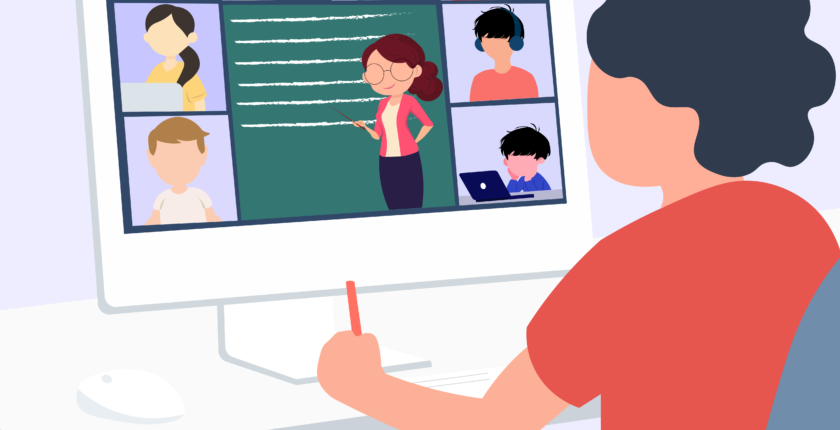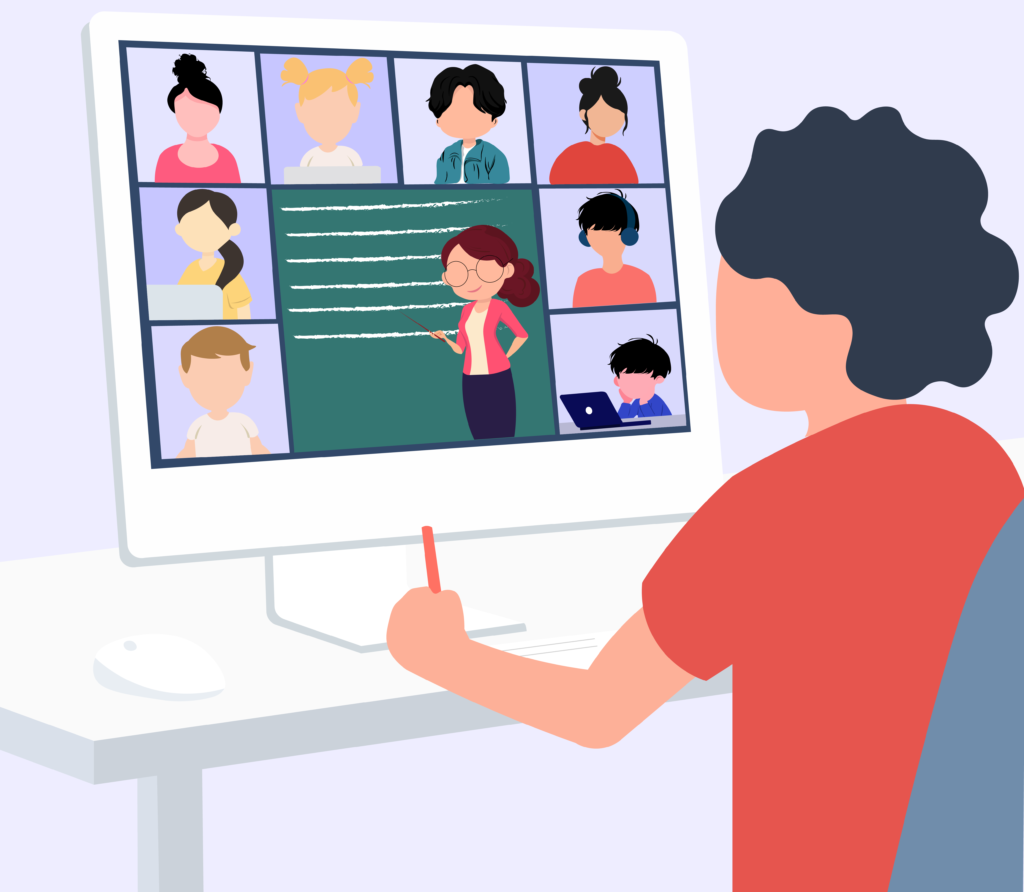About Us
Why Kids Are Failing Online Schools
- November 15, 2020
- Posted by: Olga Werby
- Category: Supermarket Science Background

I have spoken with several San Francisco administrators and learned that many (too many) kids are getting failing grades this semester in their online version of public schools. Having watched one particular kid and his mother trying to grapple with online education and having made online learning the subject of my dissertation, here are a few ideas on why these kids are not succeeding.
Brick-and-mortar schools have a lot of educational support structures built in — classrooms, desks, bells, easy access to teachers… food. Students move as herds — easy to know what to do, just follow the crowd. If a kid is standing confused in the hallway during class time without a hall pass, someone will find him and make sure he is returned to the right classroom. In class, a student can also reach out for help from a fellow student: What did the teacher just said? What’s the homework? Do you have an extra pen? All those interactions are like a supportive net that helps each student just a little. But it all adds up.
Online schools are different. There, even rules of behavior are not settled. Is it ok to eat during a Zoom class? Students don’t feel compelled to ask for permission to stand up and walk away from their computer screens for a bit (let’s say to go to the bathroom). And it would be distracting if they did ask for permission. The standard discipline of all-eyes-on-me doesn’t work as well when the teacher can’t see all of her students at the same time. And for a teacher, there is no quick way of judging if a kid is not ok. In-person, it’s easy to tell if a child is limping or had been crying, or exhibiting unusual behavior. But if all you have is their face? Kids fall through the virtual cracks.
An in-person class is very different from an online class, and it is a mistake to treat them as if they are functionally the same…because clearly, they are not and educational outcomes bear this out.
So let’s take a few of these ideas and break them down a bit more carefully.
The Concept of Scaffolding
At its most basic, Educational Scaffolding refers to a series of support structures that have been built into school activities that help students focus on the main point of instruction (as opposed to a myriad of other distracting and often detrimental activities). Kids who flail about during instruction might do just fine if they had appropriate support systems. Ideally, these Educational Scaffoldings are individualized to the child’s needs. But ALL kids need to have support structures to do well. Early on, parents and teachers provide those, later, students are able to take the task themselves. The goal of education is to teach children how to learn and to transfer the responsibility for their own learning from teachers directly to students. Schools are supposed to teach that, in addition to providing a basic introduction to the various subjects.
Here are a few examples Educational Scaffolding:
A Dedicated Study Place. A child that has difficulties reading, requires a quiet, comfortable place to read with few distractions. Having a television blaring in the background or loud arguments or extreme traffic noise, etc., can sap up attention away from reading, making these children too distracted to focus on the text and reduce their reading comprehension. But even in a family that tries to give its children space, there might be more than one child in an online class at the same time. Having two simultaneous lectures in the same room is hard. In households that don’t have the ability to provide quiet, individualized space for each child, learning is more difficult through no fault of the child.
Dictionary. We gain vocabulary over time. The most active vocabulary acquisition is during school. At school, new vocabulary words are posted all over the walls of the classroom as a reminder to the students. Technology also helps — in many reading apps, clicking on a word inside a book provides a definition of that word. Both of these examples — the physical and the technical — are examples of an Educational Scaffolding.
Scheduling. Schools have day schedules built-in — the bell rings and students know to either sit down and pay attention or rush to the new destination or move on to a different subject. Such break ups of the day into sitting and concentrating and rushing around are useful to students. Schedules break up the day into manageable chunks. Most kids are not able to sit still for longer than an hour. They need a little release of pent-up energy. And students can also watch the clock (clocks are common in most physical classrooms) to see how long before they get that break — “I just need to focus for 10 more minutes.” Knowing how long the activity will last gives students (and people in general) the tool they need to manage their attention. Duration is a bit more difficult to judge on a Zoom class — there is no count down (or up) to the end of the class. Classes also take longer and there is no physical activity between classes to shake off excess energy.
Classroom Notices. Most physical classrooms have a dedicated place on a wall or a blackboard where kids know to look for assignments. A student can tell with a simple glance that there is homework and when it is due. Such notices are a constant reminder of work to be done. This too is a very powerful Educational Scaffold.
Breaking Up Large Assignments into Manageable Tasks. Most teachers help their students form a plan on how to complete their long-term assignments. There are physical reminders in the classroom. There are often a gallery of exemplars of projects that got A’s in previous years. Students can see what’s expected of them and form appropriate expectations. In an online class, even if there are examples of work, they are hidden under layers of screens. A child might discover them or might not. And since they are out of sight, they are mostly out of mind…at least for younger students.
In-Class Work. Having students work on assignments in class allows the teacher to walk around and inspect students’ work in progress. It is easy to spot a kid who is uncertain of what to do or is doing something wrong. In such cases, a teacher can provide just in time assistance and set the child on the right path. A teacher can also give kudos to kid who is doing excellent work…right there, on the spot. All this is not possible in an online setting. A teacher who is “looking over the shoulder” of her online student is not able to “keep an eye” on the rest of her class.
Group Work. Many school projects are broken up into groups where kids collaborate on a final presentation. Optimally, groups are created to match students’ strengths and weaknesses. Decades ago, when I was working in an Oakland Middle School, I saw first hand how some kids, who were underperforming individually, revealed themselves as excellent group leaders and organizers. Different kids naturally excel in different areas and develop skills at different rates. Group projects are a good way to support a diverse body of students. …and they are very hard to do virtually without a lot of support systems.
Books: This is an often overlooked aspect of schools. Most schools have libraries and a collection of books in the classrooms. How are students get their books now? Most public libraries are closed. Some bookstores are now open, but parents might not feel safe taking an outing at a bookstore. Buying books, even online, is expensive, so books become a luxury items easily available to the privileged few. This will have long-term consequences. Students who are struggling in online school might be fine in the long-term if they read regularly. But reading is taking a hit. Even those kids who have all they need (technologically speaking) to succeed in an online school environment are relying more on video content than reading. What will be the long-term consequences of learning information via video format? Will the students retain information for long? How is video comprehension different from reading comprehension?
Of course, these are just some very basic examples of Educational Scaffoldings. Most classrooms are brimming with them; we just fail to notice them or take them for granted. So this brings me back to online education. If you would like to read a bit more, here is an article on “Musings on Failure in School.”
Technical Problems
- Many students have inadequate computing systems at home. Yes, the San Francisco Unified School District gave each student a Chrome Book. The District also purportedly provides technical support for that system to the families who need it. In my (rather limited) experience, this support left a lot to be desired.
- Poor internet connection is common among children from lower socioeconomic households. We’ve all seen kids working in the parking lots of 7 Eleven because they don’t have an internet connection at home. [Read more about connectivity issues and economics.] But even those who have access tend to have intermittent problems. More than once, I’ve seen a spinning ball of death as a child tried to connect to his online classroom. Sometimes, the connection simply broke up during class or the video feed stuttered so badly that it was all but impossible to follow what was going on.
- There are parents who don’t have access to computers at home. Yes, it’s a thing. Some parents ONLY have a mobile phone. It is virtually impossible to access the Parental Portal for San Francisco Unified School District with just a mobile phone.
- And it’s not just parents and students. Teachers too have problems with the school online learning systems. They might miss noticing that one of their kids didn’t click the “here” button while actually having attended their class. Teachers might have problems with their own computer systems and connectivity. Working from home, teachers have to become their own personal IT departments. Yes, there are phone numbers to call in case of trouble. But troubleshooting why a computer system suddenly stopped working as expected is difficult and time-consuming from a distance.
- Not all students have access to printers.
To solve some of these issues, there are now companies that schools can contract with who specifically specialize in providing IT support to children! But even with IT support, things derail often. On my family Zoom meeting of 5 people this morning, it took 35 minutes just to get everyone to sign up…there were technical difficulties. If an online class is only one hour and has 30 students, how much of that time is spent on technical glitches on a regular basis? Last night, we had a storm that knocked out power for almost 24 hours to about 48 homes. It’s a freak thing, but if a family doesn’t have a phone or the school doesn’t answer its phone (a VERY common occurrence), then children from this neighborhood would be cutting school…if anyone notices them being gone.

Lack of Technical Expertise and Flexibility
This is really a three body problem:
- Children who are not used to using technology for school are not going to magically excel at using computers. For those students, computers become additional barriers to learning. They have to become expert users in technology in addition to learning new subject matters. This is problematic. It’s like teaching kids how to read without teaching them their letters first. One is foundational to the other. And not all kids showing up in the online classroom are equally versed in technology.
- Parents (and guardians who are home with kids who are in an online school) are also not equally fluent in the use of technology. How many grandmothers can solve a login problem that their kid might be experiencing? How many parents can fix a connectivity problem? How many can come up with a workaround?
- A twelve-year-old kid can be legally left home alone in California. This means that a lot of seventh-graders and older with working parents might be navigating their online learning alone. A lot also help their younger siblings (as 12-year-olds are old enough to babysit too). These children are also left to make their own food and to solve whatever problems that might come up at home or in their online schools. There are no home nurses for sick kids to visit…
- If a teacher has 30 kids in her online class, it is unlikely that she can see all of them (as small icons around the main content) as well as her presentation to the class. So at best, a teacher can focus briefly on the few kids that are visible and try to remember to switch between kids during the week.

Modal Issues
Knowing where and how to look for the information to solve a problem is not a simple task. Most adults are not fluid at this. A lot of adults don’t have a firm grasp of how to use their remote controls where mode switching allows them to navigate between various input options: cable, VCR (yes, some still have those), Netflicks Accounts, Amazon Pro, Apple TV, Games, and a ton of other possibilities accessible for viewing on their screens.
The modal problem can be broken down into two:
- The person doesn’t even know the information exists somewhere.
- The person knows that there must a way of getting information, but has no idea of how to do so. Let me add to this that some children know that information exists for a short period of time but because they are not continuously reminded of its existence, they promptly forget. This is not because these students are uncooperative or bad, it is just that part of their cognitive development hasn’t happened yet. They need outside help to remember — this reminding is also a form of Educational Scaffolding.
Obviously, these are different problems, requiring different solutions. For example for those students who routinely “miss” homework assignments or class, prior to assuming that they are obstinate students, it might be prudent to:
- Instead of relying on students to navigate through a series of complex hierarchical screens, consider emailing their assignments directly to them. Also, include parents on these emails — often, parents have no idea what is assigned or how to find out.
- Break assignments up into manageable chunks (hopefully, individualized to each student — what’s manageable is a variable based on the student’s cognitive and psychological development).
- Work with each student to manage their progress. Most kids give up if they believe that there is no path from where they are to where you want them to be. This is just human nature. Think of this as if your doctor tells you to lose 50lbs — most people would just laugh it off: there’s just no way. Students can get overwhelmed, too.
- Many kids fail because they missed something small but essential — if a student doesn’t understand how to compute a common denominator, for example, a whole series of cascading failures can occur on material that requires this as a prerequisite skill. I found this particularly common when I evaluate children who are struggling in school — I look for that one bit of failure and they try to correct it. Most kids feel relief when they realize that they are not naturally bad at math.

Don’t Give Up
Mass online education of our children during the world-wide pandemic is an experiment. We are bound to get a lot of things wrong and kids will fail to learn. But not everything needs to be solved by adding extra screens or creating complicated technical workarounds. Many problems of failure are just problems of communication. And communication is always very hard.
If your kid is not doing well, if your child is struggling, try reaching out to the teachers directly. Tell your kid to do so, too. Teachers are people. They are tired and stressed. If they don’t know the kid and see that the student is not even trying — they can’t see the student trying — then they focus on those kids that want to work with them. It might not be fair, but we have to teach our kids to be their own educational advocates. We have to tell them to reach out to their teachers and ask for help. This is especially true for children whose parents can’t act as their advocates because they either lack the language skills, or the time (because they work full time), or they have a problematic social situation that makes reaching out to teachers difficult. This is one of the reasons that I believe that Educational Family Co-ops are a good idea. The children can participate in public schools online learning initiatives AND still benefit from the small knit community of other learners and their guardians to solve the above-mentioned problems.
